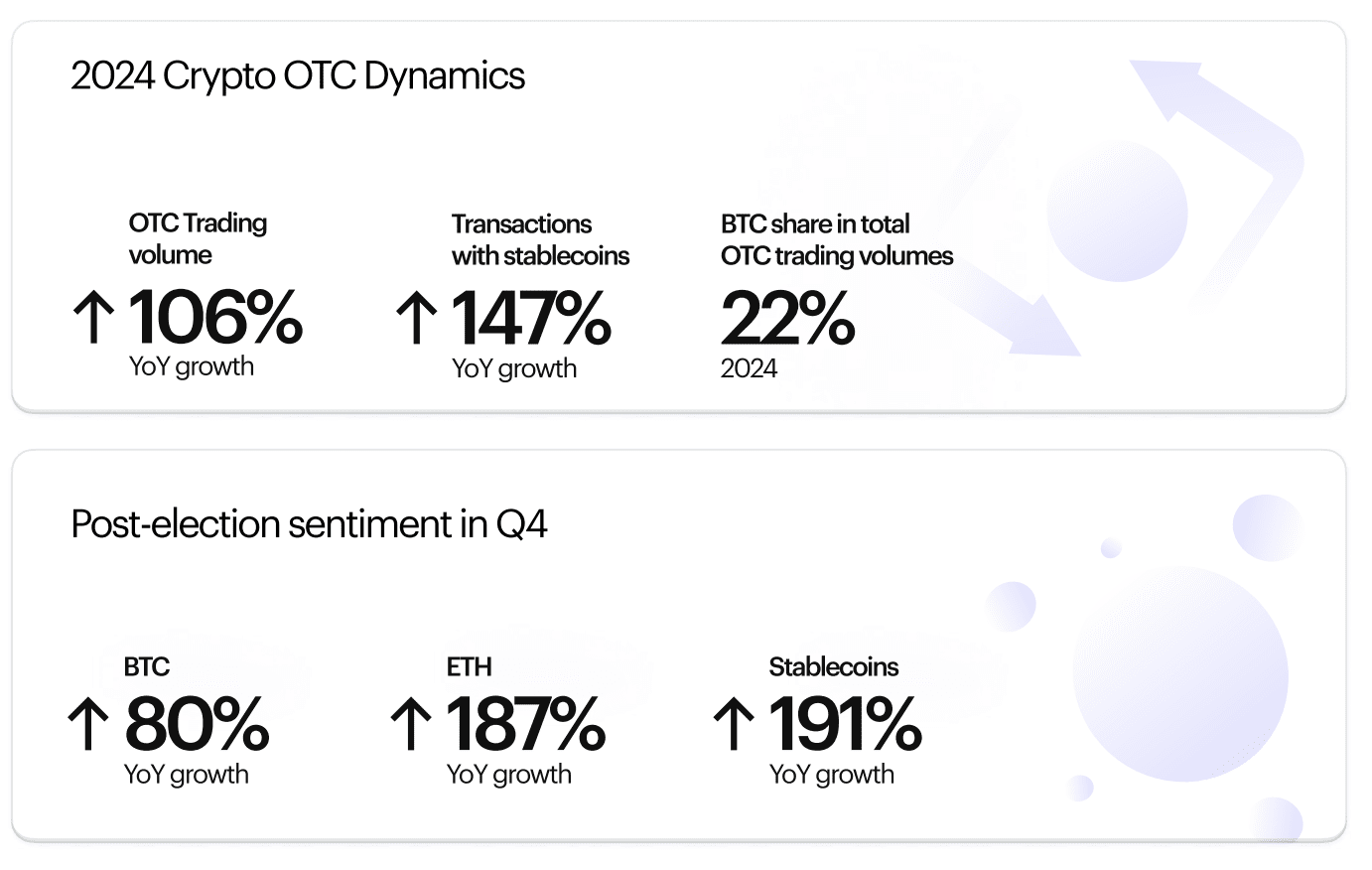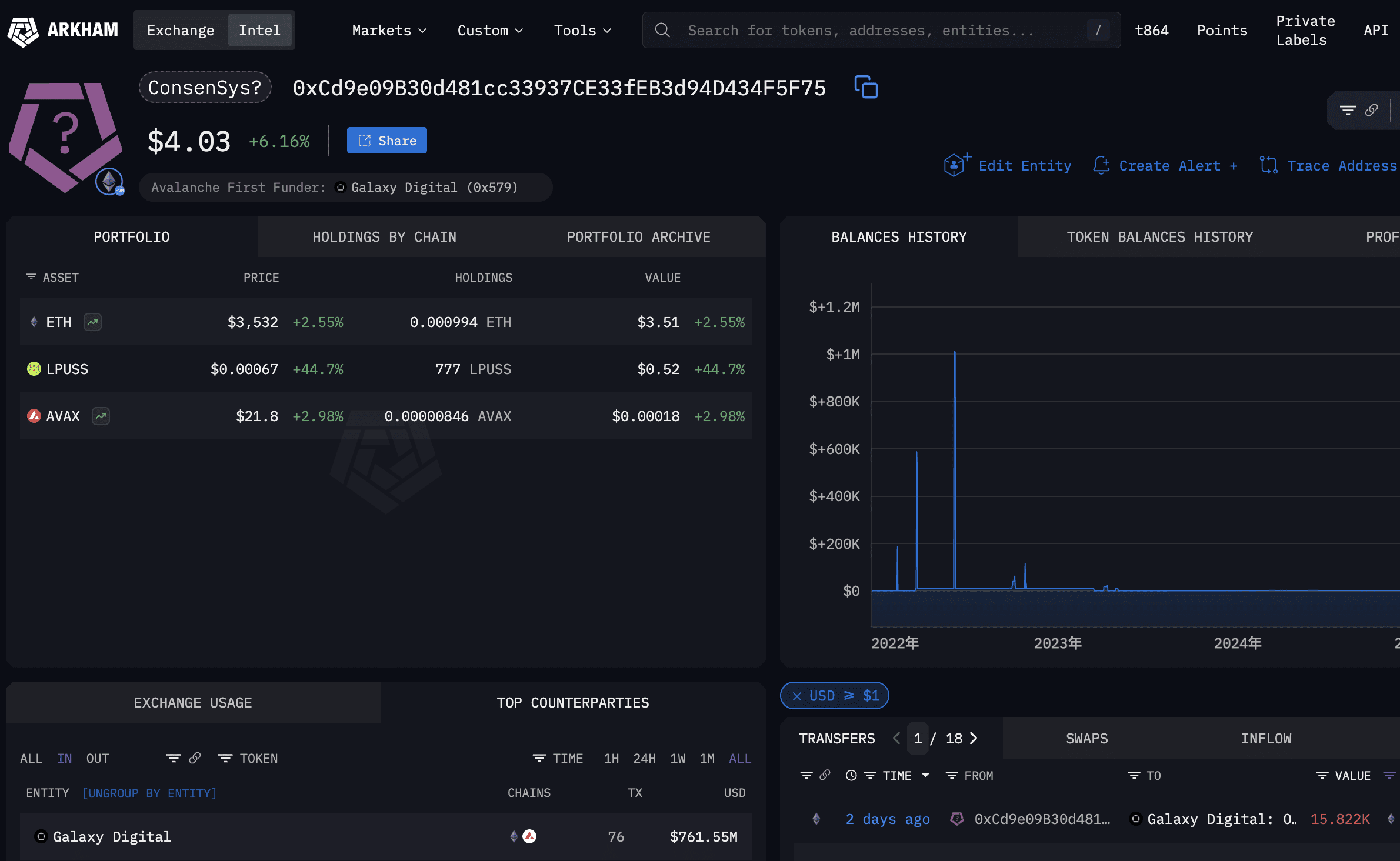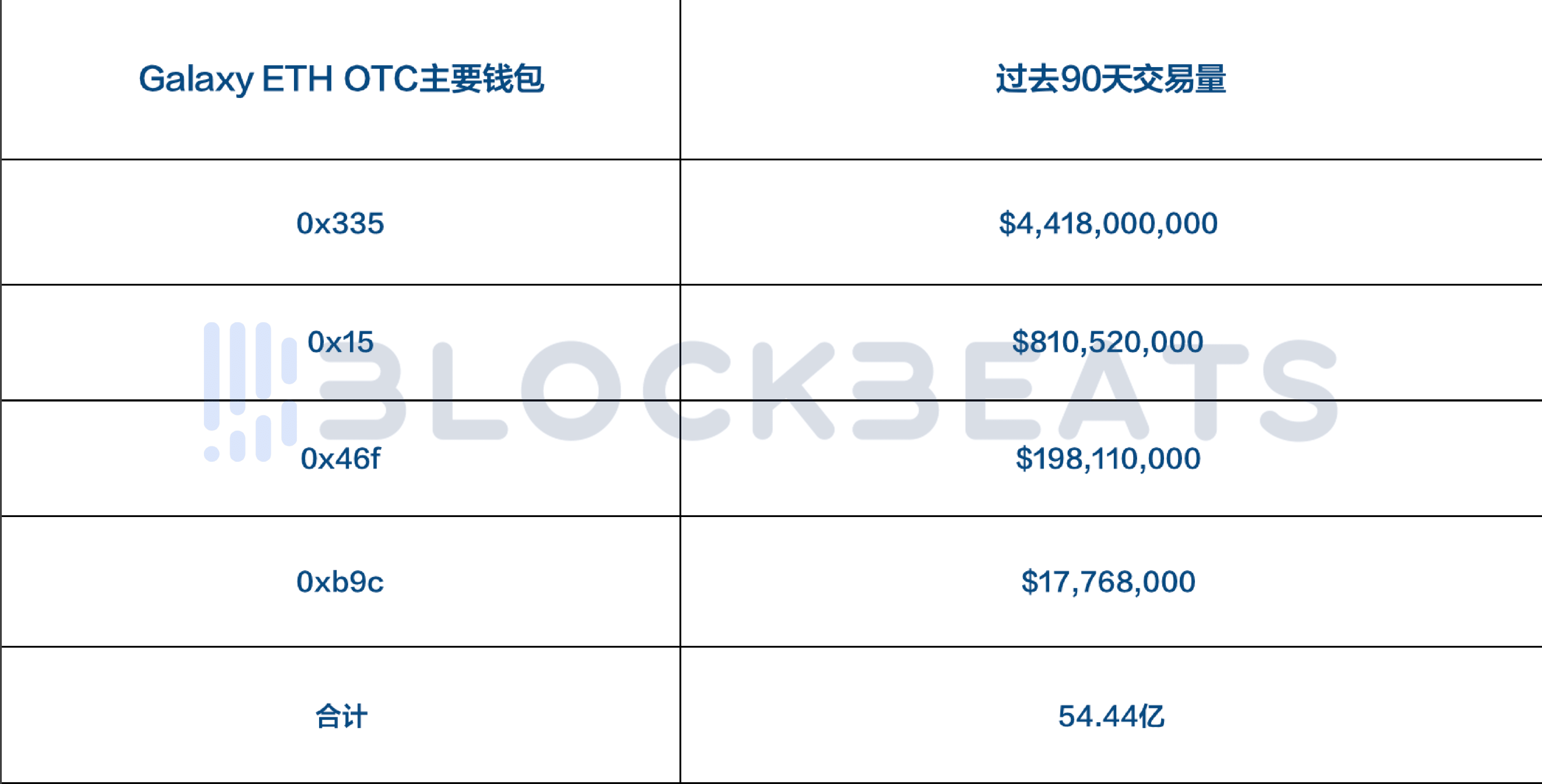There have been two explosive points in the development of cryptocurrency OTC platforms: for 2024, it was the approval of Bitcoin and Ethereum ETFs, while the EU and regions like Dubai have gradually introduced frameworks (MiCA, VARA) that allow OTC desks to operate legally on a large scale, as institutions need to quickly procure target assets. By 2025, it was after former President Trump proposed the concept of 'crypto capital', the overall inclination of traditional finance made a 360-degree turn, and after the introduction of various new crypto policies, Bitcoin reached new highs and Ethereum surged strongly in early 2025, leading to explosive growth in OTC platform trading as institutions rushed to allocate assets.
Generally speaking, OTC trading matches buyers and sellers directly. They provide a single quote, hence there is no slippage or bidding, and transfers are completed through custodial wallets and institutional accounts. Because orders never touch the public limit book, the market never sees your hand. As a 'dark pool' of the cryptocurrency market, OTC institutions do not disclose the specific trading details of their users, but unlike traditional finance, we can find clues from on-chain queries.
In July 2025, one of the largest-scale Bitcoin OTC trades occurred, with a total of 80,000 BTC changing hands for approximately $9 billion, yet the public market remained largely unaffected. The orchestrator behind this was Galaxy Digital, the most favored 'crypto OTC institution' on Wall Street today, which also led to a 268-fold increase in its Q2 revenue forecast year-on-year.
What role did OTC platforms play in this compliance wave? How did Galaxy Digital leverage its resources to flip the script in stock trading? Rhythm BlockBeats conducted a series of studies on this topic.
The third major pillar of liquidity in crypto
With this wave of institutional enthusiasm, OTC platforms have evidently become the 'third major pillar of liquidity' in the crypto market, following centralized exchanges (CEX) and decentralized exchanges (DEX). For large funds, CEX/DEX are often unable to accommodate hundreds of millions of dollars in buy orders without causing severe volatility, so OTC platforms play the role of 'white gloves' for institutions, completing accumulation or liquidation behind the scenes.
Throughout 2024, there was not a single month where OTC trading volume fell below the level of the same month last year, indicating that market participants are increasingly inclined to trade through private channels rather than openly betting on the market. In their view, the crypto industry has gradually transformed from marginal speculation into an acceptable asset allocation option, with Wall Street evolving from skeptics to participants. This growth was even more exponential in 2025.
Finery Markets points out that an increasing number of traditional financial leaders are moving from 'watching' to 'neutral or accepting', which is a key reason for the surge in OTC trading volume. When more trades are conducted in dark pools, the apparent market volatility may be significantly smoothed out. According to Finery Markets' report for Q4 2024, OTC platforms saw an overall trading volume increase of 106% compared to the previous year, while in the first half of 2025, OTC spot volume grew by 112.6% compared to the first half of 2024.

It is worth noting that while the compliance environment is improving in Europe and the United States, the Asian OTC market is also on the rise. Licensed OTC platforms in Hong Kong, emerging platforms in the UAE and Southeast Asia are attracting global large order liquidity. Meanwhile, some traditional block trading market makers like Flow Traders are also active in this space, using high-frequency and quantitative strategies to provide bilateral quotes for large crypto trades, improving execution efficiency and reducing impact costs. These factors collectively solidify OTC's status as the invisible pool in the crypto market.
The thriving Galaxy Digital
Among the many OTC players, Galaxy Digital, founded by Mike Novogratz, is undoubtedly a star in this wave of institutional buying frenzy. Galaxy is a well-known crypto investment bank and operates a high-reach OTC trading business covering trading, investment, asset management, consulting, and mining. Its clients include listed companies and top players such as hedge funds. However, the main pillar of profitability is OTC spot trading and investment. Backed by the founder's 20 years of Wall Street experience and the compliance shaping of the company's listing, an increasing amount of institutional funds has flowed in, showcasing incredible large-scale trading performances on Galaxy's platform, covering mainstream assets like ETH and BTC as well as popular coins like SOL and BNB.
Epic transaction of 80,000 BTC lands smoothly
As mentioned earlier, the one-time OTC trade of 80,000 Bitcoin worth up to $9 billion within four days set a record for one of the largest single trades in crypto history, and the intermediary for this trade was Galaxy Digital.
On July 25, Galaxy Digital announced that it had been commissioned to complete this huge BTC sale for an early investor from the 'Satoshi Era'. It is said that this was part of the investor's estate planning, and Galaxy did not disclose the client's identity, only stating that the transaction was part of a broad wealth management strategy. Surprisingly, the clearing of these 80,000 BTC had almost no impact on the market. Starting from July 17, ancient on-chain addresses became active, transferring Bitcoin to Galaxy Digital's OTC addresses in just a few days, and the clearing of these 80,000 Bitcoin did not reflect in the Bitcoin price. Although a few days later, after Galaxy's announcement, there was a brief drop of nearly 4%, temporarily falling below the $115,000 mark, the price quickly rebounded to around $117,300 within a few hours.
Analyst Jason Williams pointed out that this massive sell-off has been 'completely absorbed' by the market, while another analyst, Joe Consorti, lamented that '80,000 Bitcoin (over $9 billion) were sold at market price, yet the BTC price barely budged.' On one hand, this further tests the current market's OTC depth, as there are counterparties able to absorb such a large volume of sell orders shortly after being matched on exchanges. On the other hand, it also reflects the importance of 'dark pool trading' in today's cryptocurrency domain. In fact, based on the already disclosed OTC address (bc1q0), the total value of Bitcoin handled by the Galaxy OTC Deck weekly reaches hundreds of millions to billions of dollars, and the actual figure may be even higher.
Preference for ETH in stock companies
In Q2 2025, multiple unusually large buy orders appeared on the Ethereum chain, attracting close attention from the community. Since July 9, 14 new wallet addresses have cumulatively purchased an astonishing 856,554 ETH through OTC platforms such as Galaxy Digital or FalconX, valued at approximately $3.16 billion. These wallets had no historical transactions on-chain before suddenly accumulating large amounts in OTC channels, indicating that 'big players are quietly increasing their ETH holdings.'
On-chain analysis firm Arkham Intelligence pointed out that starting from late July, a newly created wallet address (0xdf0A…2EF3) accumulated approximately $300 million worth of ETH through Galaxy Digital's OTC trading desk in just three days. This address once held 79,461 ETH, costing about $300 million, and at the time's market value of approximately $282.5 million, it showed a paper loss of about $26 million (about an 8.7% drawdown). This indicates that while the whale's average purchase price was relatively high, they remain resolutely increasing their holdings.
Just today, August 5, three new addresses acquired a total of 63,837 ETH worth approximately $236 million through Galaxy and FalconX. EyeOnChain disclosed some of these buyer addresses, including 0x55CF…679, 0x8C6b…60, and 0x86F9…446, among others. It is estimated that the cumulative buying intensity of these addresses reaches tens of millions to hundreds of millions of dollars, with a single wallet's holdings exceeding 110,000 ETH (valued over $400 million) at one point.
Where does this buying power come from? There are indications pointing to SharpLink Gaming, which began loudly claiming in June 2025 to emulate the MicroStrategy strategy by continuously increasing its holdings of Ethereum as a primary treasury asset. According to its announcements and on-chain data, SharpLink crazily bought nearly 500,000 ETH through ATM financing and OTC trading from June to the end of July. As of July 27, the company held 438,190 ETH, a 21% increase from the previous week, having purchased over 77,000 ETH in one week at an average weekly price of about $3,756.
As of the end of July, SharpLink has cumulatively purchased approximately 449,000 ETH. Entering August, the company continued to accumulate, spending $43.09 million to buy 11,259 ETH on July 31, and again purchasing 18,680 ETH from Galaxy on August 4. Analysts estimate that SharpLink's total holdings have surpassed 499,000 ETH, with an average cost of about $3,064, currently valued at around $1.8 billion, resulting in an unrealized profit of about $275 million. Such a massive buying spree in Ethereum was almost entirely completed through OTC desks like Galaxy and FalconX, with even the founder of Wintermute joking that 'it's nearly impossible to buy ETH on our OTC desk now because the whales have already cleared out the supply.' Besides SharpLink, which currently holds the second largest amount of ETH, Bitmine, the current largest holder, is also a close partner with Galaxy.

The associated address 0xCd9 has transferred over $800 million in ETH to SharpLink. $153 million in ETH 0xdf0, approximately $300 million in 0x286, and several other addresses are linked to both.
While we cannot clarify where such concentrated large-scale OTC accumulation comes from, it is clear that this undercurrent is becoming a key force influencing ETH supply and demand. According to rough calculations by Rhythm BlockBeats based on several main Galaxy on-chain OTC addresses, the OTC trading volume in ETH has reached $5.444 billion over the past 90 days, averaging about $1.8 billion per month.

According to Arkham, the public information of four OTC wallets 0x335, 0x15, 0x46f, and 0xb9c.
Acting as both referee and player, the MicroStrategy drama unfolds on the BNB Chain
If BTC and ETH are the main characters in 2024, then starting in the second half of 2025, BNB also stepped onto the stage of institutional layout. In July, an unexpected piece of news emerged: CEA Industrial Company (stock code VAPE, originally a company focused on agricultural temperature control and e-cigarettes) listed on NASDAQ announced it would completely transform into a 'BNB Treasury Company', planning to raise up to $1.25 billion through private placements and exercising options to purchase BNB. This plan caused VAPE's stock price to soar 550% in a single day.
More notably, the mastermind behind VAPE's crypto pivot is David Namdar, co-founder of Galaxy Digital. He will serve as the new CEO of VAPE, while Russell Read, a partner from 10X Capital and former Chief Investment Officer of the California Public Employees' Retirement System (CalPERS), will take on the role of CIO. Namdar stated that they will actively build BNB positions with this fund of up to $500 million (potentially expandable to $1.25 billion) over the next 24 months, including public market purchases, strategic trades, and earning yields through staking and decentralized finance.
This indicates that BNB will welcome its first large-scale public market institutional buyer, and OTC channels will undoubtedly play a key role in this process. Due to the highly concentrated issuance and circulation of BNB, Binance and its founder Changpeng Zhao (CZ) reportedly control 71% of circulating BNB. To absorb hundreds of millions of BNB without causing drastic market fluctuations, they can only rely on OTC block trades or protocol transfers. Galaxy Digital's rich OTC network and liquidity resources will provide strong support for this 'BNB version of the MicroStrategy initiative' led by Namdar. As the third largest cryptocurrency by market capitalization, this move marks BNB's official entry into the institutional asset allocation arena.
Whether it's the custody, trading, and on-chain ecosystem integration platforms like Coinbase or the consulting + OTC trading arrangement of Galaxy Digital, or the rapid convergence of traditional brokers and trading platforms, various sectors in the cryptocurrency field are beginning to move towards compliance and a concentration of resources towards leading players. The recent launch of a Crypto Project may signify this notable trend, with the era of compliance institutions nearing, and the OTC platforms in cryptocurrency serving as a 'transparent dark pool' possibly occupying a more important ecological position in the future.



